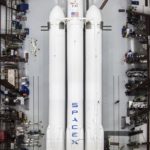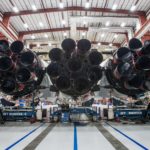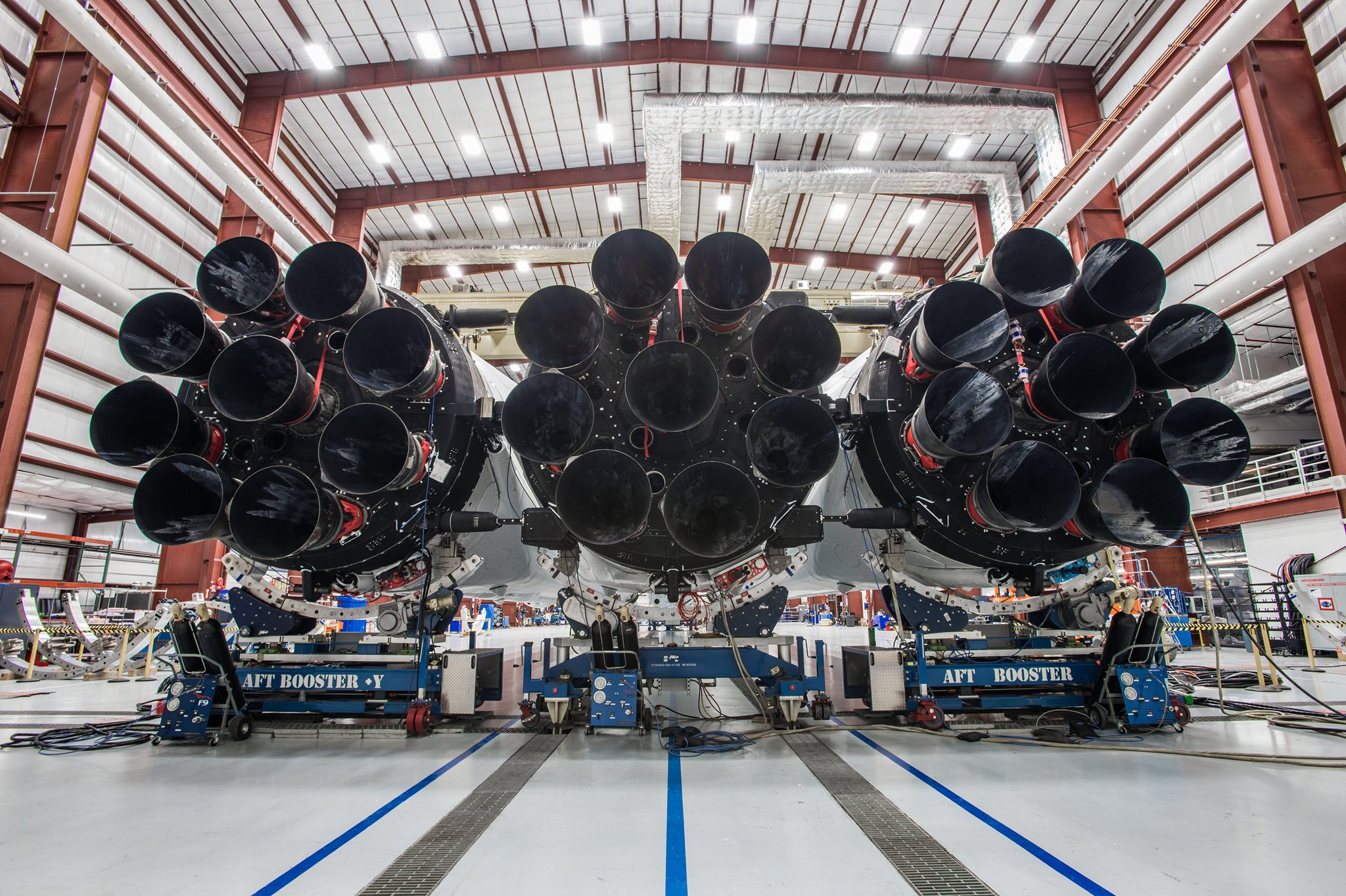
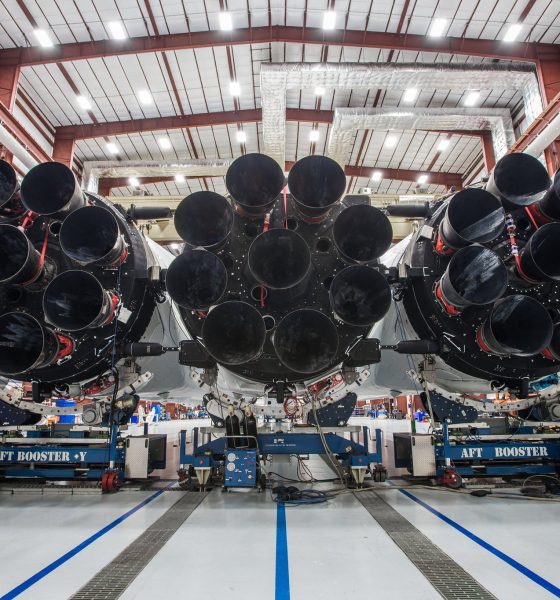
News
SpaceX’s Falcon Heavy launch imminent as Elon Musk unveils first photos
For the first time in SpaceX’s history, the company is close enough to the inaugural launch of its massive Falcon Heavy rocket that the vast majority of the vehicle is already at Cape Canaveral, FL, and all three of its first stages have been mated together.
- The first Falcon Heavy, seen here fully integrated aside from its payload fairing. (SpaceX)
- Falcon Heavy’s three boosters and 27 Merlin 1D engines on full display. (SpaceX)
We know this because Elon Musk took to Instagram and Twitter last night and posted the first-ever real-life photos of the launch vehicle, currently stationed at the Horizaontal Integration Facility (HIF) at SpaceX’s LC-39A launch pad.
At launch, Falcon Heavy will only be surpassed in thrust and payload by the megarockets of the 1960s, the US Saturn V and the Soviet N-1. Best described by an eager employee, Falcon Heavy will have the same thrust as fifteen 747 Jumbo Jets at full throttle, and could nearly carry a fully-loaded 737 passenger jet into low Earth orbit (LEO) in a fully expendable configuration.
Over the past several weeks of inactivity, SpaceX’s pad technicians have been hard at work modifying the LC-39A launch pad and its Transporter/Erector/Launcher (TEL) to support the inaugural launch of Falcon Heavy. This mainly involved considerably upgrading the water deluge system used to muzzle the impact of the sheer sound created at launch, but also required the addition of four more hold-down clamps, necessary to abort a launch after engine ignition. An additional array of communications wiring and umbilical connections for fueling have also likely been added to the TEL in order to support the requirements of what are essentially three simultaneous Falcon 9 launches.
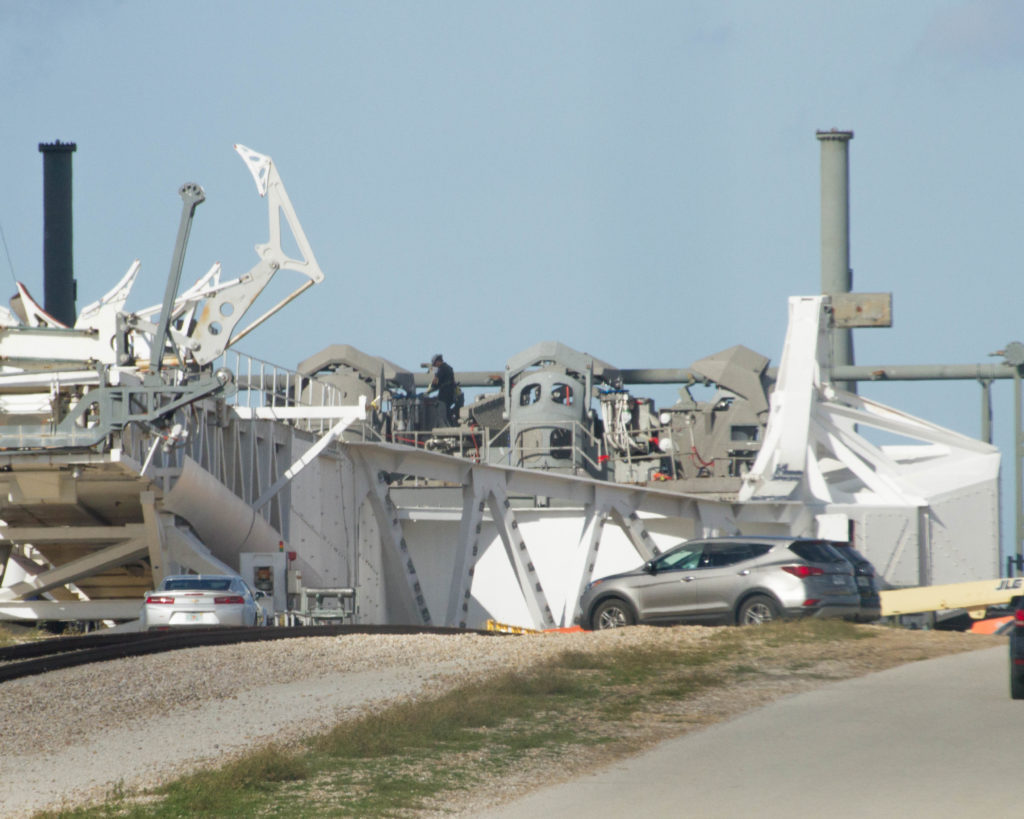
Pad 39A’s TEL undergoing modifications. Hold-down clamps are the grey enclosures seen at the end of the TEL. Note the worker standing in the middle for a sense of scale. (Tom Cross/Teslarati)
A lack of frenetic activity at the pad in the last handful of days suggests that those modifications are nearly complete, and SpaceX fans and followers are now eagerly awaiting the rollback of the TEL to 39A’s integration facilities, where Falcon Heavy will soon after be integrated with the TEL for the first time ever. After this milestones, we can expected Falcon Heavy to be rolled out the pad for what is known as a wet dress rehearsal (WDR), akin to a launch or static fire but without any engine ignition. It’s possible that a bug-free WDR could fluidly transition into the first static fire for the vehicle, but it is probable that SpaceX will take a more cautious approach with this launch campaign. Following the successful completion of the WDR and static fire, Falcon Heavy’s inaugural launch will be imminent. We are potentially no more than 40 days out, the closest SpaceX has ever been to a Falcon Heavy launch.
Of note, the final picture posted by Musk offers an absolutely stunning view of the vehicle’s business end, showing off its 27 Merlin 1D engines and revealing quite obviously that both of Falcon Heavy’s side cores are flight-proven, whereas the center core is new. The photos provided also offer a glimpse of the only component clearly missing, the second stage and its mysterious Tesla Roadster payload. Unconfirmed whispers in the fan community have it on good authority that the Roadster has in fact already been mated to the second stage’s payload adapter, and transport to the Cape and integration with the full Falcon Heavy stack are undoubtedly imminent.
Falcon Heavy at the Cape pic.twitter.com/hizfDVsU7X
— Elon Musk (@elonmusk) December 20, 2017
Possibly most significant of all, Musk suggested that the Roadster payload would be sent on a course to Mars, although it has yet to be concluded whether that will be in the form of a general orbit similar to Mars or an actual trans-Martian injection culminating in an orbit around the Red Planet. The former is far more likely, but the latter would be an extraordinarily impressive test of SpaceX hardware in deep space, a necessary precursor for the company’s goals of interplanetary colonization. Time will tell, and in the meantime we can expect a veritable flood of rocket and payload photos as SpaceX rapidly approaches a historic moment for the company.
Be sure to follow us on Instagram as we go bring you live video and behind the scenes coverage from Cape Canaveral at each SpaceX launch!

News
Man credits Grok AI with saving his life after ER missed near-ruptured appendix
The AI flagged some of the man’s symptoms and urged him to return to the ER immediately and demand a CT scan.

A 49-year-old man has stated that xAI’s Grok ended up saving his life when the large language model identified a near-ruptured appendix that his first ER visit dismissed as acid reflux.
After being sent home from the ER, the man asked Grok to analyze his symptoms. The AI flagged some of the man’s symptoms and urged him to return immediately and demand a CT scan. The scan confirmed that something far worse than acid reflux was indeed going on.
Grok spotted what a doctor missed
In a post on Reddit, u/Tykjen noted that for 24 hours straight, he had a constant “razor-blade-level” abdominal pain that forced him into a fetal position. He had no fever or visible signs. He went to the ER, where a doctor pressed his soft belly, prescribed acid blockers, and sent him home.
The acid blockers didn’t work, and the man’s pain remained intense. He then decided to open a year-long chat he had with Grok and listed every detail that he was experiencing. The AI responded quickly. “Grok immediately flagged perforated ulcer or atypical appendicitis, told me the exact red-flag pattern I was describing, and basically said “go back right now and ask for a CT,” the man wrote in his post.
He copied Grok’s reasoning, returned to the ER, and insisted on the scan. The CT scan ultimately showed an inflamed appendix on the verge of rupture. Six hours later, the appendix was out. The man said the pain has completely vanished, and he woke up laughing under anesthesia. He was discharged the next day.
How a late-night conversation with Grok got me to demand the CT scan that saved my life from a ruptured appendix (December 2025)
byu/Tykjen ingrok
AI doctors could very well be welcomed
In the replies to his Reddit post, u/Tykjen further explained that he specifically avoided telling doctors that Grok, an AI, suggested he get a CT scan. “I did not tell them on the second visit that Grok recommended the CT scan. I had to lie. I told them my sister who’s a nurse told me to ask for the scan,” the man wrote.
One commenter noted that the use of AI in medicine will likely be welcomed, stating that “If AI could take doctors’ jobs one day, I will be happy. Doctors just don’t care anymore. It’s all a paycheck.” The Redditor replied with, “Sadly yes. That is what it felt like after the first visit. And the following night could have been my last.”
Elon Musk has been very optimistic about the potential of robots like Tesla Optimus in the medical field. Provided that they are able to achieve human-level articulation in their hands, and Tesla is able to bring down their cost through mass manufacturing, the era of AI-powered medical care could very well be closer than expected.
News
Tesla expands Model 3 lineup in Europe with most affordable variant yet
The Model 3 Standard still delivers more than 300 miles of range, potentially making it an attractive option for budget-conscious buyers.

Tesla has introduced a lower-priced Model 3 variant in Europe, expanding the lineup just two months after the vehicle’s U.S. debut. The Model 3 Standard still delivers more than 300 miles (480 km) of range, potentially making it an attractive option for budget-conscious buyers.
Tesla’s pricing strategy
The Model 3 Standard arrives as Tesla contends with declining registrations in several countries across Europe, where sales have not fully offset shifting consumer preferences. Many buyers have turned to options such as Volkswagen’s ID.3 and BYD’s Atto 3, both of which have benefited from aggressive pricing.
By removing select premium finishes and features, Tesla positioned the new Model 3 Standard as an “ultra-low cost of ownership” option of its all-electric sedan. Pricing comes in at €37,970 in Germany, NOK 330,056 in Norway, and SEK 449,990 in Sweden, depending on market. This places the Model 3 Standard well below the “premium” Model 3 trim, which starts at €45,970 in Germany.
Deliveries for the Standard model are expected to begin in the first quarter of 2026, giving Tesla an entry-level foothold in a segment that’s increasingly defined by sub-€40,000 offerings.
Tesla’s affordable vehicle push
The low-cost Model 3 follows October’s launch of a similarly positioned Model Y variant, signaling a broader shift in Tesla’s product strategy. While CEO Elon Musk has moved the company toward AI-driven initiatives such as robotaxis and humanoid robots, lower-priced vehicles remain necessary to support the company’s revenue in the near term.
Reports have indicated that Tesla previously abandoned plans for an all-new $25,000 EV, with the company opting to create cheaper versions of existing platforms instead. Analysts have flagged possible cannibalization of higher-margin models, but the move aims to counter an influx of aggressively priced entrants from China and Europe, many of which sell below $30,000. With the new Model 3 Standard, Tesla is reinforcing its volume strategy in Europe’s increasingly competitive EV landscape.
News
Tesla FSD (Supervised) stuns Germany’s biggest car magazine
FSD Supervised recognized construction zones, braked early for pedestrians, and yielded politely on narrow streets.

Tesla’s upcoming FSD Supervised system, set for a European debut pending regulatory approval, is showing notably refined behavior in real-world testing, including construction zones, pedestrian detection, and lane changes, as per a recent demonstration ride in Berlin.
While the system still required driver oversight, its smooth braking, steering, and decision-making illustrated how far Tesla’s driver-assistance technology has advanced ahead of a potential 2026 rollout.
FSD’s maturity in dense city driving
During the Berlin test ride with Auto Bild, Germany’s largest automotive publication, a Tesla Model 3 running FSD handled complex traffic with minimal intervention, autonomously managing braking, acceleration, steering, and overtaking up to 140 km/h. It recognized construction zones, braked early for pedestrians, and yielded politely on narrow streets.
Only one manual override was required when the system misread a converted one-way route, an example, Tesla stated, of the continuous learning baked into its vision-based architecture.
Robin Hornig of Auto Bild summed up his experience with FSD Supervised with a glowing review of the system. As per the reporter, FSD Supervised already exceeds humans with its all-around vision. “Tesla FSD Supervised sees more than I do. It doesn’t get distracted and never gets tired. I like to think I’m a good driver, but I can’t match this system’s all-around vision. It’s at its best when both work together: my experience and the Tesla’s constant attention,” the journalist wrote.
Tesla FSD in Europe
FSD Supervised is still a driver-assistance system rather than autonomous driving. Still, Auto Bild noted that Tesla’s 360-degree camera suite, constant monitoring, and high computing power mark a sizable leap from earlier iterations. Already active in the U.S., China, and several other regions, the system is currently navigating Europe’s approval pipeline. Tesla has applied for an exemption in the Netherlands, aiming to launch the feature through a free software update as early as February 2026.
What Tesla demonstrated in Berlin mirrors capabilities already common in China and the U.S., where rival automakers have rolled out hands-free or city-navigation systems. Europe, however, remains behind due to a stricter certification environment, though Tesla is currently hard at work pushing for FSD Supervised’s approval in several countries in the region.
